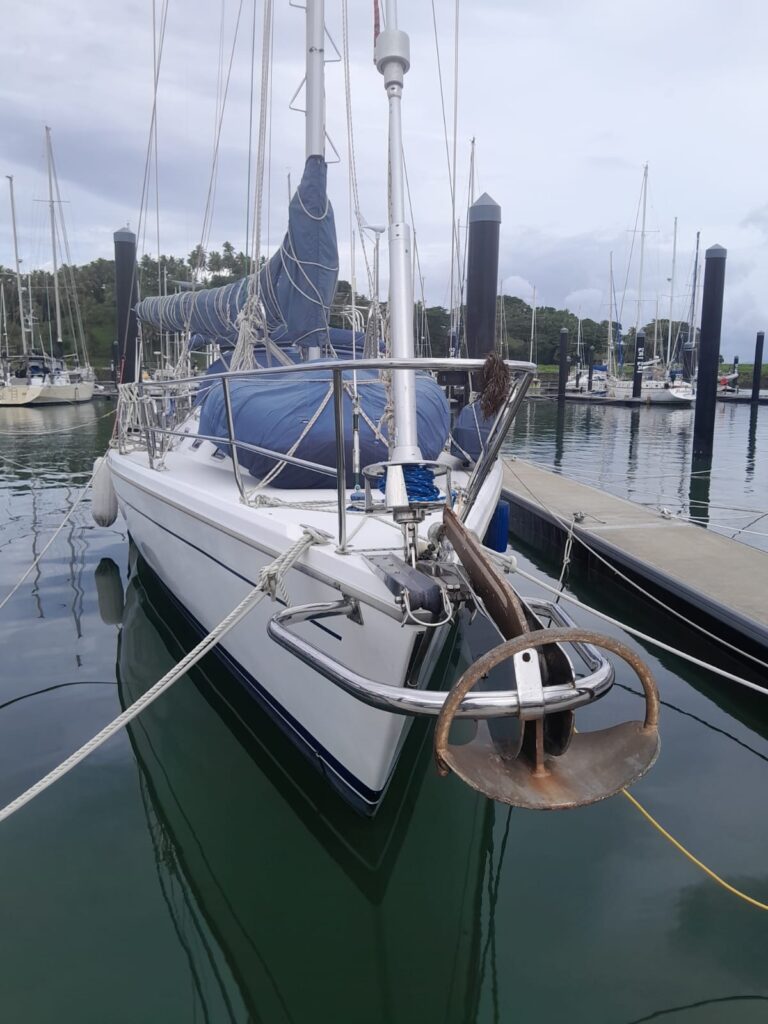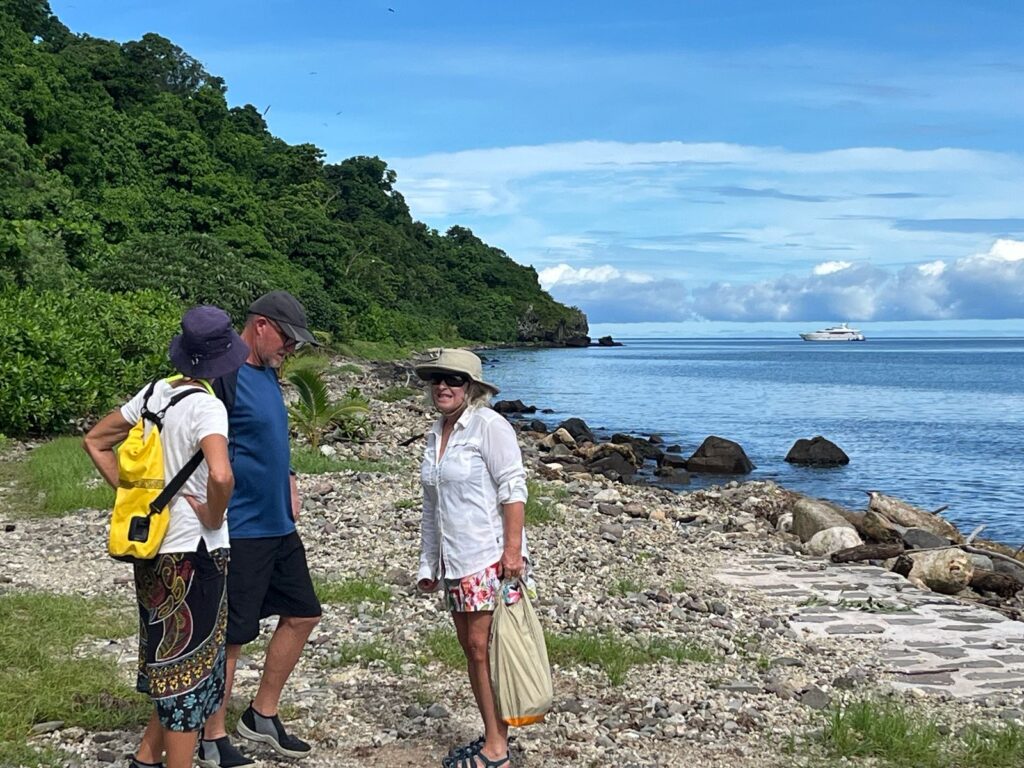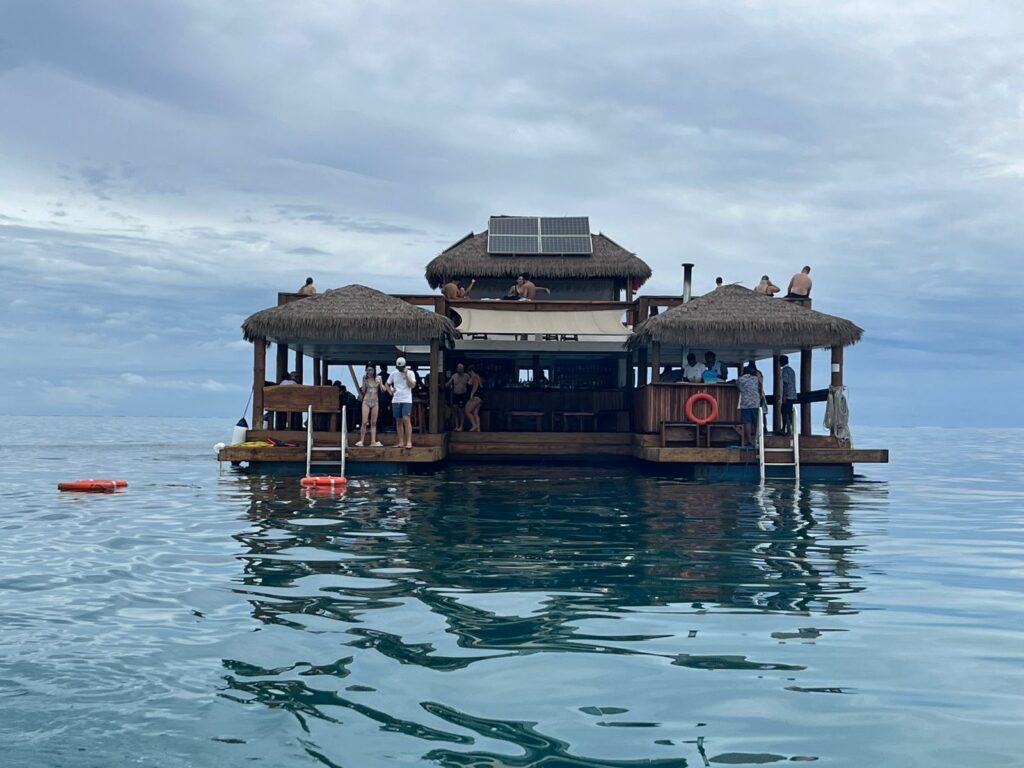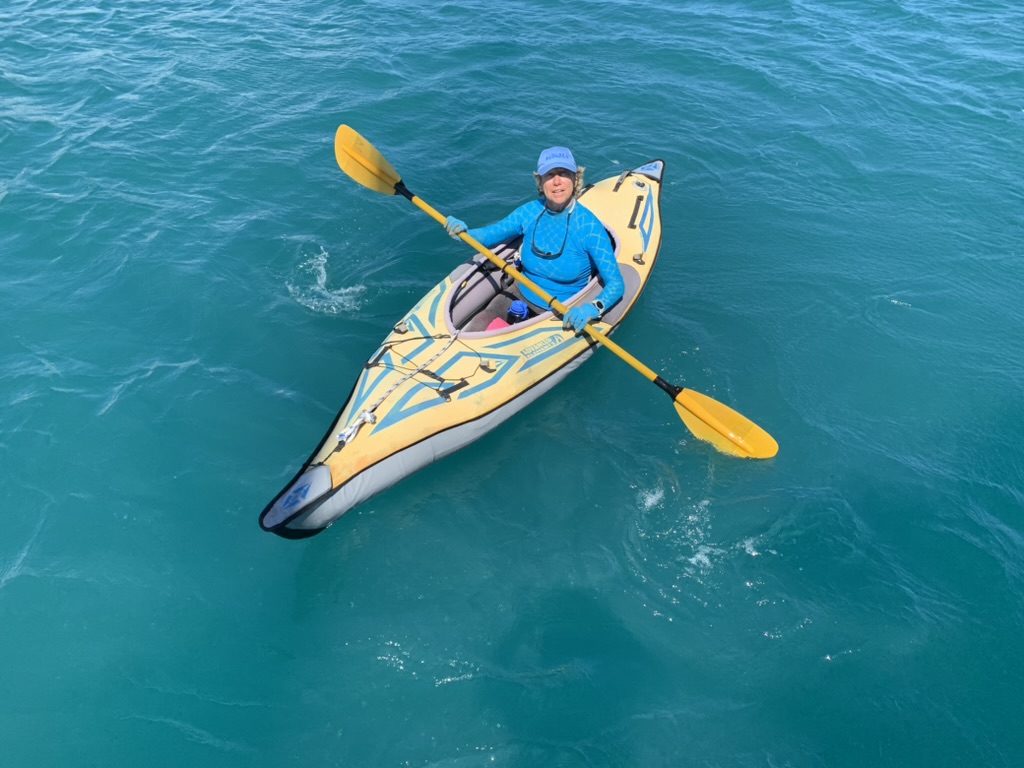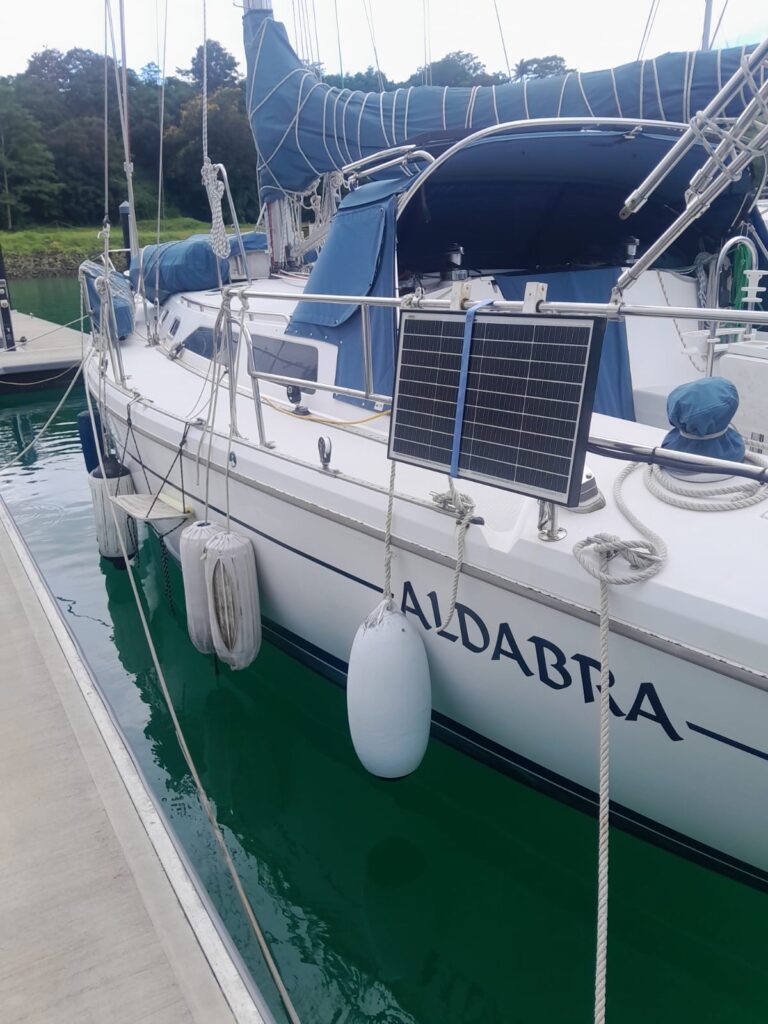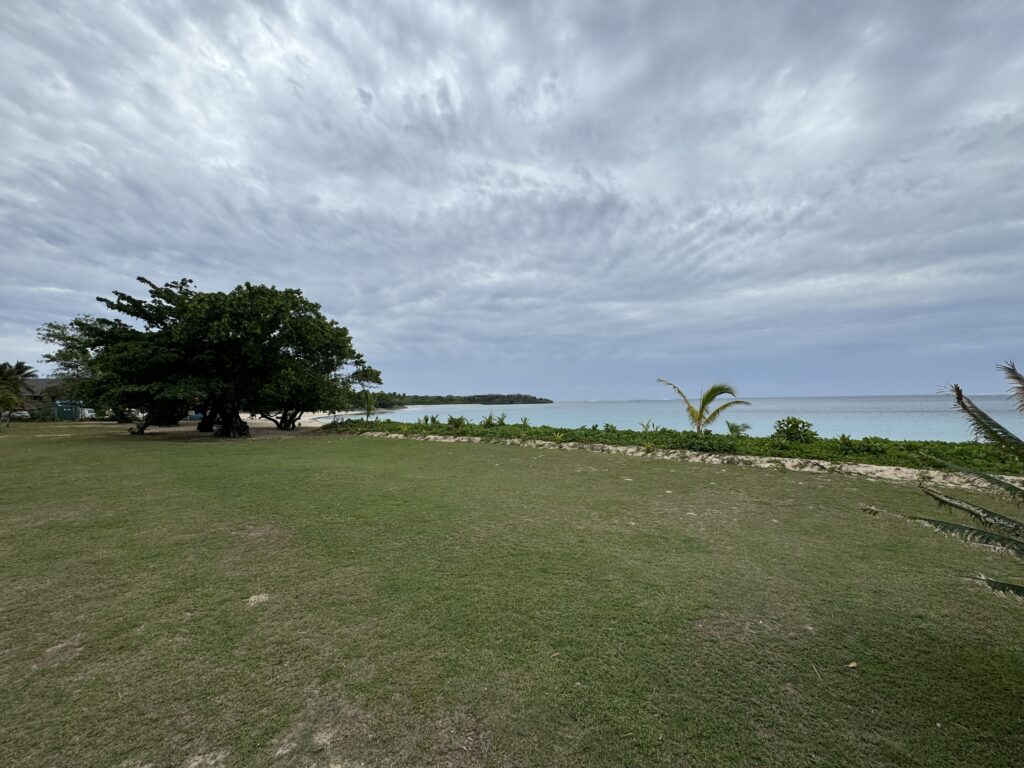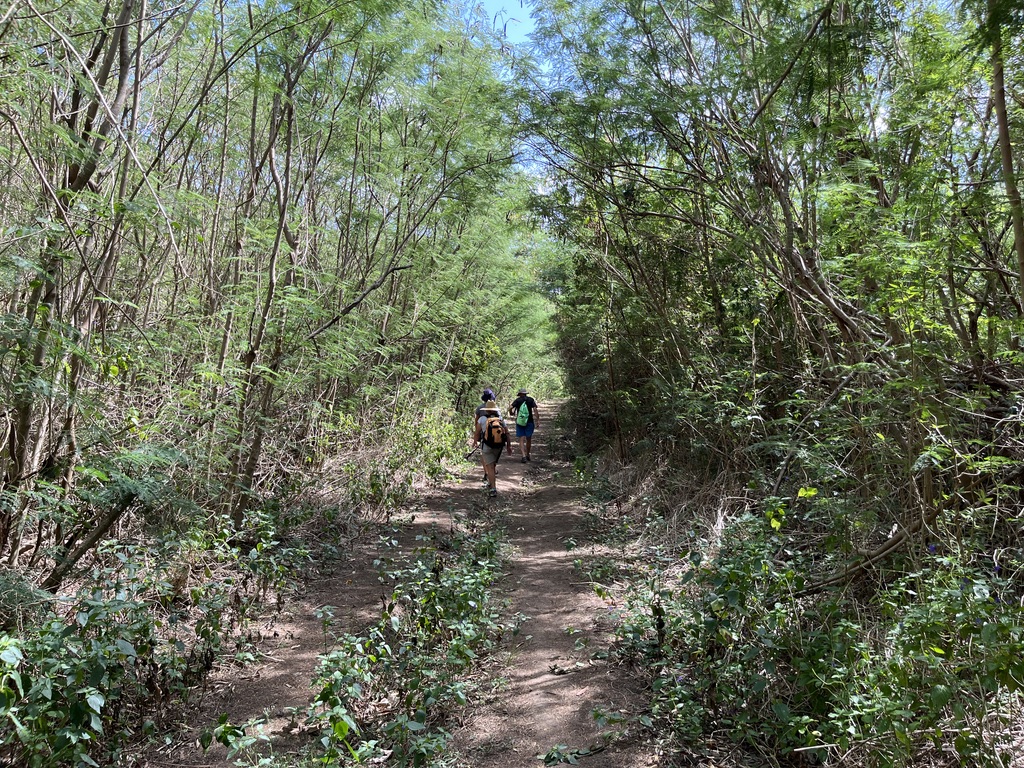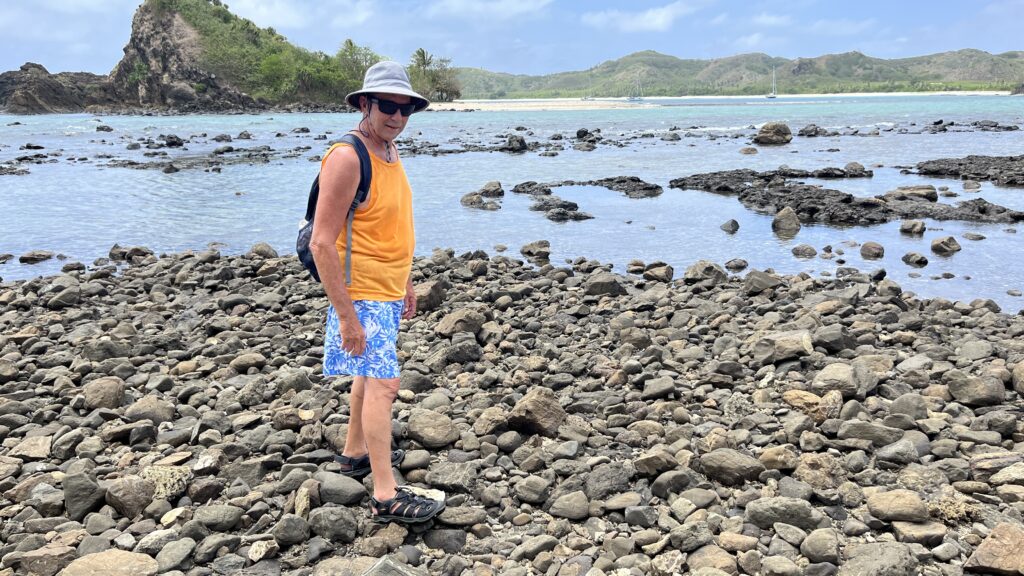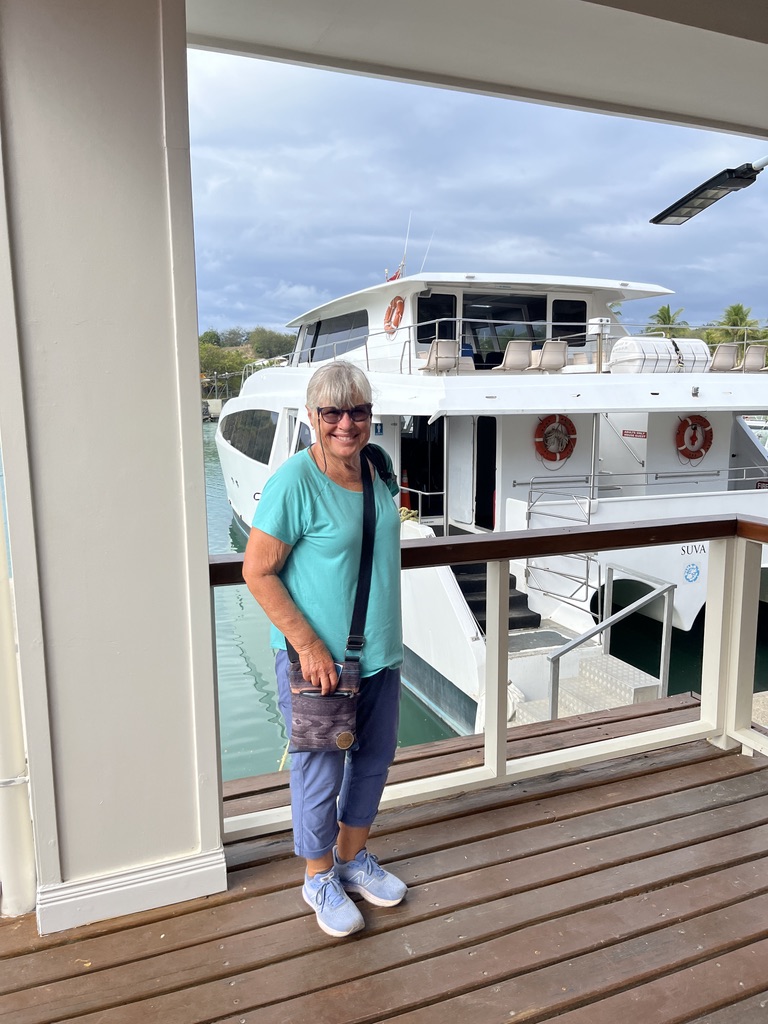When we left Pentecost Island on Tuesday, June 10, we motored and sailed east across to Crab Bay on Malekula Island. It’s a nature preserve with just enough room for two or three boats. It was beautiful and tranquil and looked like a good place to explore in kayaks, if we were to return later. RaLa arrived just before us, and after we were anchored, we went in their dinghy over to a nearby island to walk around and explore. The island is uninhabited but once housed an education center.
The next day, we left Crab Bay around 8:00 a.m. and motored in less than 5 knots of wind south to Gaspard Bay in the Maskelyne Islands at the southern tip of Malekula Island. The bay is known for dugongs. Ian and Laura saw some on their way in, but we did not. We took a dinghy ride looking for good snorkeling and then hung out in this tranquil anchorage for the day.
On Thursday, we motored with the mainsail up west over to Lonwolwol Bay on Ambryn Island. We anchored there with RaLa, Pole Pole and Alia Vita with plans to visit the village the next day to see Rom Dancing, the traditional dance performed by men on Ambryn, which is an island known for black magic. Late in the afternoon the anchorage got very rolly so we all pulled up our anchors and moved around the corner to Craig’s Cove, which was much calmer. Jeff and I had a hard time finding a suitable spot to anchor but we finally did. We then joined the other crews for a brief visit on Alia Vita.
The next day, Jesse’s son came in a boat to take us over to Lonwolwol to see the Rom dancing. On the way, a large pod of small dolphins, with several tiny babies, swam beside our little boat. It was amazing, especially when the babies jumped out of the water.
Dolphin Video Courtesy of Ian Redwood
Once back at Lonwolwol, we met Jesse and his family and had a look around his place. Part of it was right there behind the beach at the anchorage, but most of it was a short walk from there to the garden and homes of his extended family, right beside a lake created during a volcanic eruption. He had pictures of the before and after. There had been a large hospital built by missionaries, which was wiped out by the eruption. After the Rom dancing, we had lunch at Jesse’s place before his son took us back to our boats in Craig’s Cove. We all had drinks on Pole Pole that night. We said goodbye to RaLa, because there was a possibility that we wouldn’t see them for a long time.
Rom Dancing
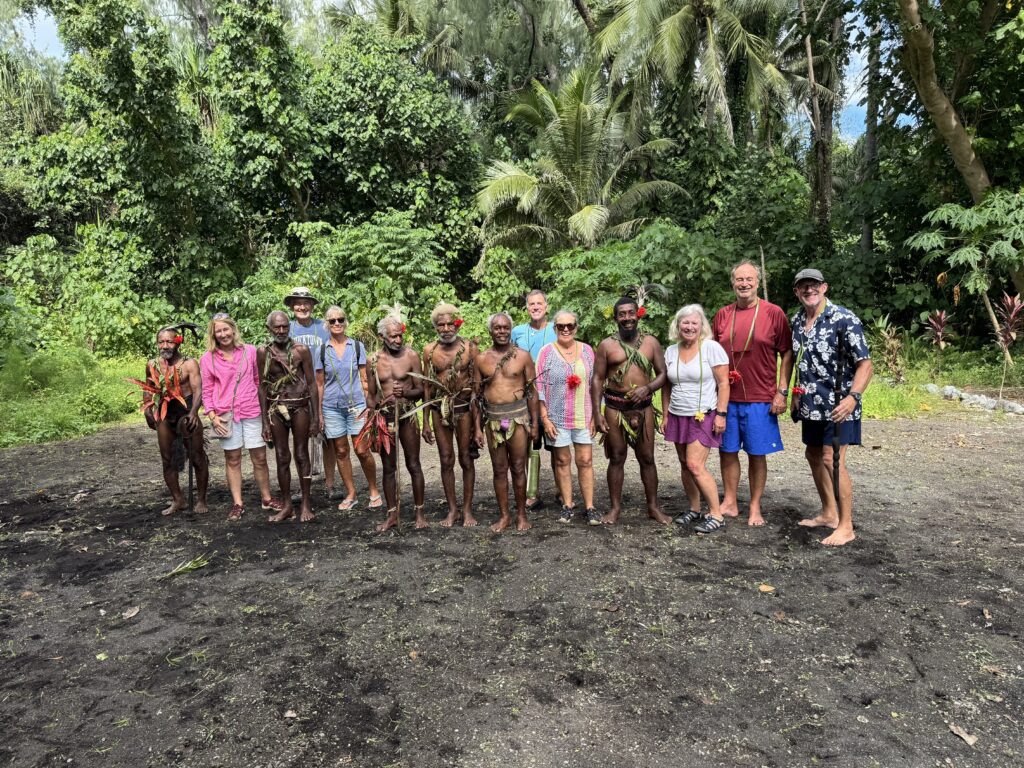
Hanging out with the Rom Dancers

Jesse’s Organic Garden
On Saturday, June 14, Jeff and I got up at 6:00 a.m. and headed back over to Malekula Island and anchored in front of Wala Island. (RaLa headed to Epi Island on their way back to Port Vila and Pole Pole and Alia Vita head to Port Stanley on Malekula Island.) At Wala Island, we met Charlie and Elizabeth and their family, and got a tour of the village. We gave some rope and other items to the family.
Then next day, we got up at 6:00 a.m. again and had a nice sail to Luganville on Santo Island. We anchored in front of the Beachfront Resort around noon. After lunch, we went to shore to the resort to ask about dinner and to arrange for a taxi for the next day. We had dinner at the resort that evening.
On Monday, we took several jerry cans to shore and a taxi took us to fill them up with diesel fuel. After we took the fuel back to the boat, we returned to shore and the taxi took us back to town to shop for provisions. We went to the vegetable market and then to the LCM supermarket. We also went to the ATM for cash. After we returned to the boat and had lunch, we pulled up the anchor to look for a better spot. We were expecting a wind event the next day, and did not want to be in that anchorage. After looking around without finding a suitable anchorage, we went out of the harbor and north to Pelakula Bay, which was very protected. Rhapsody was there as well.
On Tuesday, June 17, Jeff and I went for a walk onshore. Later we all four went snorkeling. We joined Bob and Sarah on their boat for a visit after dinner. On Wednesday, we pulled up anchor and headed north to enter Peterson Bay to anchor in front of the Turtle Bay Resort. There is a very shallow pass to get in, so we had to time it for high tide. It was tricky because we probably had mere inches between the bottom and our keel.
The anchorage in front of the resort was nice and calm. Rhapsody came in right behind us and Monsoon, another U.S. boat with a family of four was also there. We took our laundry and garbage to the resort, and then had lunch there. It was good, and we went back for dinner.
The next day, Jeff and I rented kayaks from the resort and paddled across the bay to the Matevula River. We went up the river to the blue hole. We had lunch and swam and visited with other tourists. Dinner was at the resort again than night.
Paddling up the river
Rope swing at the Blue Hole
The next day, Jeff and I went out to the main road and flagged a car down.The two young men were from a northern village. One now works in Australia and was home on a break. The other works in Port Vila and came to see his brother. They took us into Luganville so we could go to Immigration to get a letter for Johno to enter the country without a return airline ticket. We walked to multiple offices before we got everything sorted. Then we walked to town. We visited the World War II museum and had lunch. Then we went to the vegetable market and the supermarket. With all of our supplies, we coaxed a taxi to take us back to the Turtle Bay Resort, about an hour drive.
When we got back to the boat, Rob and Frances were there on Alia Vita. We stopped by to say hello and they invited us to dinner. After putting our provisions away, we joined Rob and Frances for a very nice dinner and visit. We joined them the next night for dinner at the resort.
On Sunday, June 22, it was very windy, but we wanted to get back out of the pass during high tide and daylight. We had lunch with Bob and Sarah at the resort. Then we pulled up anchor to go through the shallow pass at high tide. Once again, we had mere inches under the keel. To add to the stress, the wind was blowing in the high teens/low twenties. After checking out a couple of possible anchorages, we went back south to Pelakula Bay, knowing that it would be a safe spot for the night.
On Monday, we got a slow start in the morning, and then motored north with the jib up to Hog Harbour. On the way up, the seas were big, so we were relieved that the anchorage was pretty calm, although a bit rolly at times during the night. The next day we put the dinghy in the water and went over to see Champagne Beach and then snorkeled at the nearby reef. Then we worked on the inner forestay, which needed some attention.

Champagne Beach Near Hog Harbour
On Wednesday, we motored a few miles north to Port Olry. The anchorage was very nice. The next day, we put the dinghy in the water and went to shore. We found a small modest resort on the beach for lunch and then walked into town. When we returned to the boat, we saw that a French catamaran, Tuvau, had joined us. We went to say hello and agreed to return later for sundowners. I spent some time scrubbing the waterline of the boat and then we joined Marc and Elizabeth for drinks at 6:00 p.m. We had a very nice visit.

Rainbow in Port Olry

Lunch on shore in Port Olry
On Friday, June 27, we got up early and had the anchor up shortly after 6:00 a.m. We motored north for about ten miles before the wind came up. Then we had a lively sail to Gaua Island in the Banks group of islands. We were anchored by 3:00 p.m. in Lakona Bay. A couple of young men came out to greet us and we intended to visit the village the next day. But the anchorage was really rolly that night. So, the next day, we pulled up the anchor and motored a bit north to Bushman’s Bay, wish was much more comfortable.
In Bushman’s Bay, a man paddled out to welcome us. Later other people paddled out with fruits and vegetables to trade. We stayed on the boat on Sunday because we didn’t want to intrude on their church and family time. But before we could go ashore on Monday, we found out that all the villagers were going around the corner to another village for a religious festival. So, we got in the dinghy and hurried to shore to meet the chief, Willy, before he left for the other village. Afterwards, we did some chores and snorkeled in the bay.
On Tuesday, we went ashore to meet up with Chief Willy. He showed us around the village and took us to the primary school. We gave him some rope and 3 gallons of petrol. He gave us a papaya. After the visit, we pulled up the anchor and went around to the next bay, Matanda Bay. Chief Michel greeted us in his canoe and guided us to a good anchor spot. Then we went ashore and he gave us a tour of his village, which consisted of his extended family only. He showed us his house and his garden and we met his family members. After we went back to the boat, we snorkeled on the reef and I scrubbed the bottom of the boat a bit.

Primary school class in Bushman’s Bay
That evening, Michel returned to see if we could charge his phone and to see if he could make a call. They do not have cell coverage in his village. He came back a bit later with some relatives. We tried making a call for them but were not successful. The next day, Michel came back out and we returned his uncharged phone. We promised that we would call his sister in Luganville when we got to the next village, Losalava. Then we pulled up the anchor and went to Losalava.

Touring Chief Michel’s Garden
The trip over to Losalava was against the wind in big seas. Fortunately, it was not a long way. We were going there because we thought it would be a good anchorage for weather that we were expecting. It was okay, but not really protected. We had several visitors that afternoon. Then, the next day, we went ashore, looking for the chief. He wasn’t around, but a group of kids took us around the village and showed us the new clinic that had just been completed. As we toured around, we finally did meet the chief, but he was really busy unloading building materials from a supply boat. We said hello and then continued. The three kids who acted as our guides asked if they could come out to the boat. So, we took them with us in the dinghy. We gave them water and cookies and Jeff gave them a tour of the boat. Before we took them back to shore, we gave them gifts (a book and perfume for the girls and juggling balls for the boy).

School kids visiting the boat in Losalava
We waited out the weather for the next couple of days, doing chores and some cooking. Our plan was to head north to the next two islands in the Banks group. But we finally realized that the weather was working against us and that we wouldn’t have reasonable passages to the other islands or comfortable stays once there. So, we decided to head back south again.
On Monday, July 7, we pulled up the anchor around 10:00 a.m. and headed back to Matanda Bay. We anchored briefly and Chief Michel’s brother paddled over. We told him about our phone call with his sister and asked him to tell Michel that we were leaving. Then we pulled up the anchor again and headed to Bushman’s Bay for the night.
After a quiet night in Bushman’s Bay, we got up at 6:00 a.m. and headed back to Santo Island. Once we got passed the shadow of Gaua Island, the wind came up and we had a lively sail back to the tip of Santo. Once inside the northern islands there, we lost our wind and finally had to motor back to Port Olry. Without even tidying up, we put the dinghy in the water and went to shore.
The restaurant we had visited previously wasn’t open, but we found the small Serenity Resort next door and had beers while we visited with the owner, Angelique. Then we found another place to get an early dinner before returning to the boat.
On Wednesday, we got up at 6:00 a.m. and motored to the center of the bay before putting up the mainsail. Then we motor sailed around to the south and down toward Luganville, in big seas and light winds. Toward the end of the trip, we were able to pull out the jib and turn off the motor and have a nice sail. We returned to the anchorage at the Beachfront Resort where several boats were already anchored. We had dinner that night at the resort.
On Thursday, we did chores. Then on Friday, we took our jerry cans to shore and, after some difficulty, got a taxi to take us to the vegetable market, the LCM supermarket and the gas station. We had dinner on shore again that night.
On Saturday, we woke up early again and had the anchor up by shortly after 6:00 a.m. We motored east and then south to Malekula Island. Eventually we had a good enough angle to sail, and we arrived in Port Stanley bay around 1:00 p.m. We tried three anchorages before settling on one that would only be suitable for the night. We were expecting a strong southerly wind and needed protection from it.
After a very calm night and leisurely morning (with some chores involved), the southerly wind arrived. We pulled up the anchor and went over to the anchorage in front of the village called Litslits. We were happy with the way the anchor set and the protection we were getting there.
On Monday, we remained in that anchorage. The wind was calm at first but then started blowing from the east. After puttering around on the boat, we pulled up the anchor and went over to the anchorage in front of Uri Island. It wasn’t really protected from the conditions. We had a windy night. On Tuesday, it was more of the same, too windy to go snorkeling and too windy to move south to another bay.
Wednesday, Thursday and Friday continued with winds in the high teens and choppy wind waves. There wasn’t really any better place to move to in Port Stanley and leaving the bay to go south would be very gnarly. Becoming more resigned to the fact that we were pinned down by weather, we entertained ourselves by polishing the stainless steel railings, cooking and reading. It’s very frustrating to be stuck on the boat without going ashore or getting into the water.










